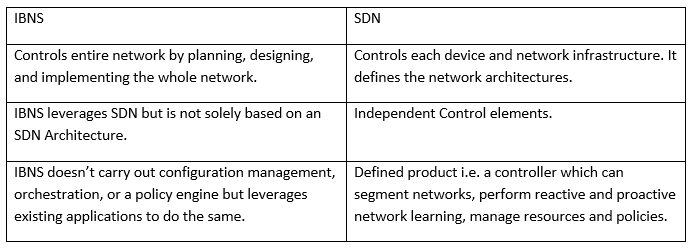Network Service Providers and standalone vendors are embracing new technologies to build a strong and scalable services. Network management using existing network orchestration solutions require manual configuration to support automation. One such example is configuring the NETCONF servers using either xml or yaml and loading the device specific config file. This type of approach increases the network downtime and considering the risks involved in human intervention, the network automation is now uplifted by an intent-based approach. Similarly, service providers have their own pain points like configuring the networking devices and managing the state of the installed policies. IBN provides a sophisticated approach to manage the devices using a single point by defining the business intent. Top network providers started delivering their intent-based applications, but there is no standard model to test the solutions. With service providers increasingly embracing an Intent based approach, there is greater need to ensure appropriate verification and validation of such solutions. We have formulated a test approach to support both the service providers and other vendors.
IBNS – A Conceptual View
IBNS (Intent based Networking System) originated when the concepts of zero touch provisioning surfaced after the advent of Software Defined Networking. SDN resolves the need to manage several millions of onboarded IoT and other networking devices. These operations create complex network problems, fixing these complex problems is a slow process and prone to errors. IBN provides intelligent solutions to resolve these problems and errors. Some IBN solution vendors have abstracted the SDN features to automate and orchestrate the business intent. There are other vendor-agnostic IBN solution providers that don’t use any of the existing SDN architectures but adopt their homegrown architectures instead to provide AL.ML enhanced SDN-like features.
Vendors have a variety of Intent Based Networking solutions and the primary difference is the underlying technology they use. Some are built on top of their network orchestrators and some over the Edge orchestrators. Overall, IBN still doesn’t have a defined operational model and is a concept that incorporates AL and ML driven network automation solutions.
How is IBNS is different from SDN?
There are some key differences that sets IBNS apart.

According to Gartner, an intent-based networking system (IBNS) incorporates four elements, which include:
- The IBNS configures network changes across the network infrastructure through network automation and/or orchestration.
- The IBNS translates business policies from users and converts them into the desired network configuration. The IBNS also generates and validates the design and configuration.
- To ensure that original business intent is being met, the system will validate in real-time and act when the desired intent isn’t satisfied.
- An IBN collects and processes the real-time network status for systems under its administrative control independent of the protocols and transport used.
Due to constant evolution, there is no predefined test approach to test these IBNS solutions and it’s very hard to think of generic scenarios to test as there is no common model. We provide you with guidance on how to write an effective and valid test approach to Test IBN solutions. Some of the main points to consider while developing a test approach for IBN are:
- Understand the Business Intent and choose the right IBN solution and infrastructure by investigating the underlying technology and the features supported. Choosing the right vendor can be very challenging and it would be prudent to take a vendor agnostic approach – more on this later.
- Conduct a strategy analysis in selecting the relevant tools and modules supporting IBN based testing.
- Write a high-level approach document and design the topology to address the business requirements.
- Make sure the approach should cover all the aspects of IBN – Business Intent aligning to customer specifications, automating the service, telemetry, SDN Southbound protocols required and the end-to-end secured service. However, some proprietary IBN solutions may not provide all these aspects, but they may be gradually implementing it which should also be considered.
- Writing the reusable APIs for the IBN solution if it doesn’t have one or use Selenium.
- Automate it with the required framework or with an on-demand automation framework.
The testing should be carried out in different test types – User Interface level, functional, non-functional, integration, system, regression, load, performance, and security testing. Detailed study and an analysis of the open source simulated southbound devices like OVS-switch and its APIs should be incorporated for a well-defined test environment and practice test data, studs and source code should be made available.
How do you go about validating a vendor-agnostic IBN Solution?
Here are some of the aspects that you need to consider –
- Environment to test the capability to address the intent violation and analyzing vulnerabilities.
- Validate the veracity of remediation steps and its compliance.
- Verify the logging changes.
- Functionality of the AI algorithm implemented to detect the potential problems.
- Validating the Seamless integration with BSS and CSS applications using APIs.
Test Approach for typical Communication Service Providers and Enterprise Network Providers:
There are some key aspects which should be considered before designing the test approach. Some of them are a) Reusability of test cases for different IBN solutions b) Automated collection of requirements to keep workflows intact c) Maximize the test case coverage d) Optimize manual testing efforts e) Latest AI tools and f) Technologies for better UI tests.
Going ahead, we have provided the various test types that need to be incorporated into a Test Approach:
- a) Functional Test: Testing the workflow from start to end.
- b) Conformance test: Customer specification conformance.
- c) Performance Test: Enable tests to measure the Peak performance of the services and verify if these generate the necessary remediation steps.
- d) Scalability Tests: Introduce ‘n’ number of devices in the network and verify the IBN solution learns about the devices within the onboarding time and they autodetect the SB protocol used to manage the device.
- e) Throughput Tests: To test whether the IBN application can identify the root cause for the issues by collecting and processing continuous complex service telemetry data. As a result, test the IBN solutions guided remediation steps and recommendations.
- f) Resource Utilization Test: Validate the resource utilization from south bound layer till the Application layer.
- g) AI driven Application Testing: There are AI test tools available in the market which serve as an extension to current GUI test tools. It significantly reduces the test time and improves the efficiency with anticipating downtimes and errors.
Conclusion
A pre-defined Test framework solution customized for IBNS will offer Service Providers an opportunity to validate their solutions within a planned period by adhering to the evolving standards prescribed for an IBN solution from both industry and customer specifications.
To accelerate the automation and provide intelligence to validation, we can leverage the AL/ML algorithms tests which can collect logs and recommend optimized solutions to reduce the overall validation cycle time.

is a Technical Lead – Product Engineering Services at Happiest Minds Technologies with hands on experience in all phases of Automation Test Framework development cycle, L1-L3 Protocol testing and Openstack/SDN. She has extensive experience in developing Network Protocol test suites, IOT and Embedded test framework. She has designed and developed test frameworks for L2-L3 protocols, IoT, SDN, Embedded, Openstack and also worked on frameworks for conformance and Functional testing.
She holds a bachelor’s degree in Electronics & Communication Engineering.




